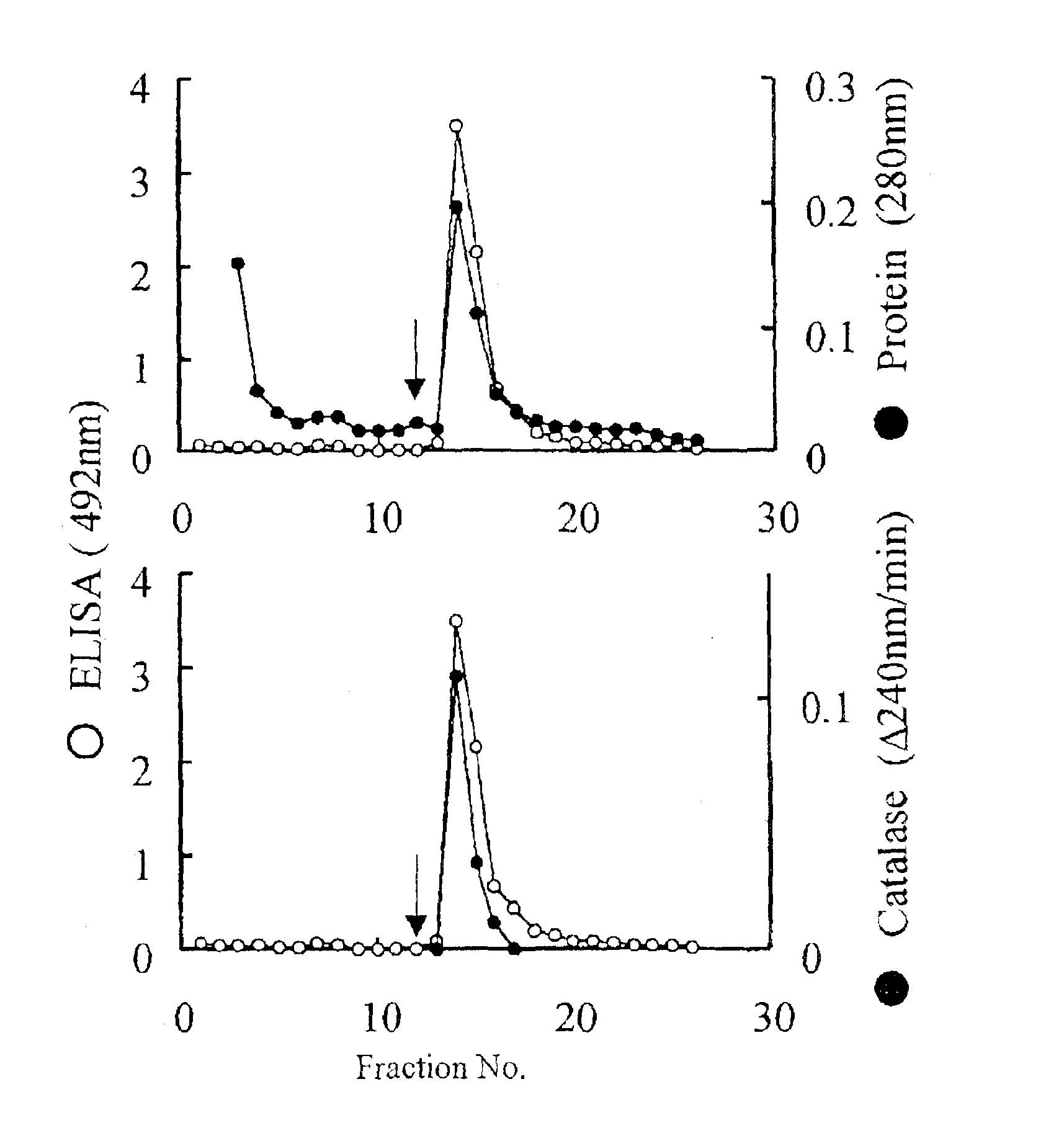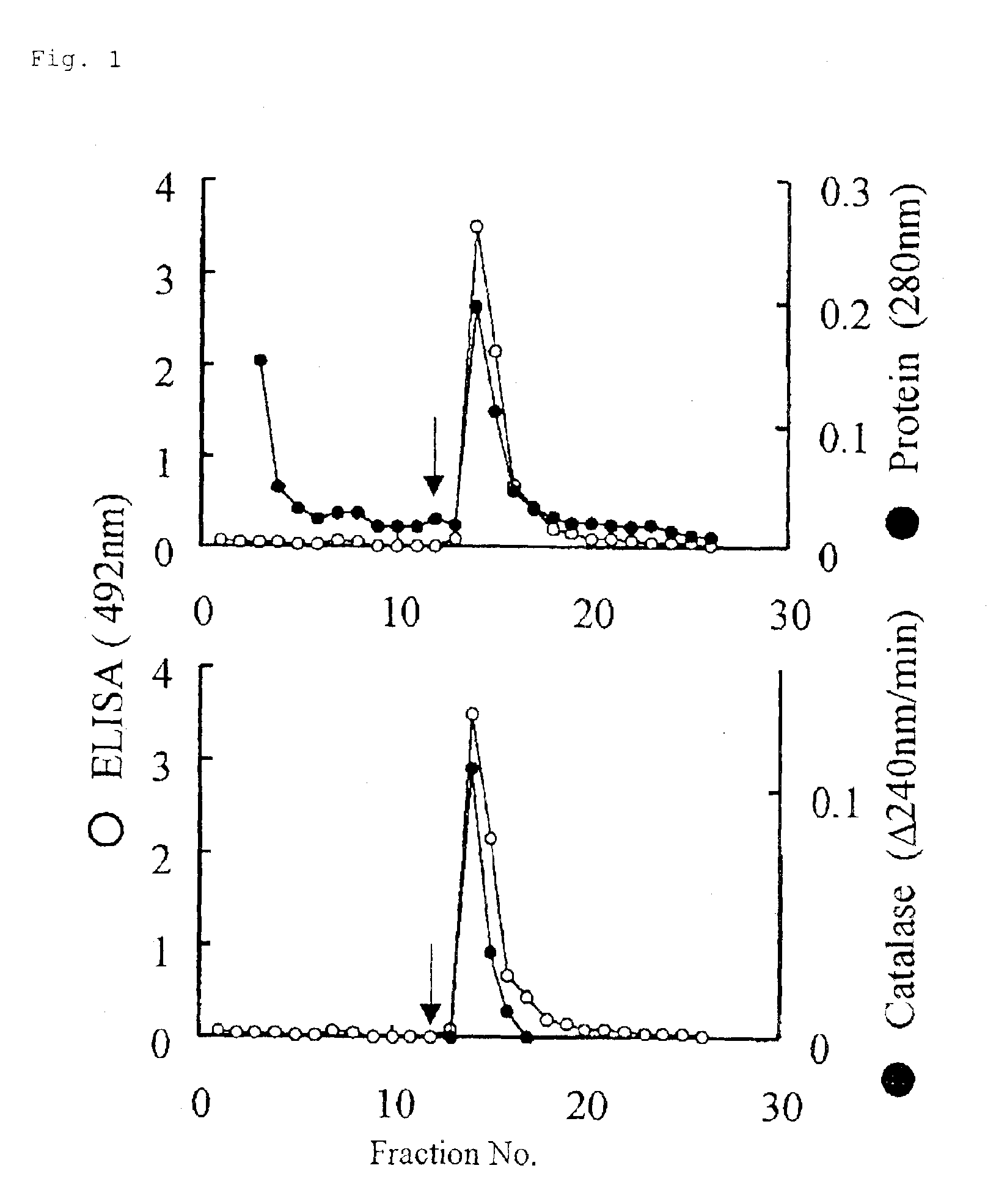Monoclonal antibody hybridoma immunoassay method and diagnosis kit
a hybridoma and antibody technology, applied in the field of monoclonal antibody hybridoma immunoassay method and diagnosis kit, can solve the problems of high cost, inconvenient diagnosis, and inability to judge the effect of bacterial eradication by antibody test, etc., and achieve excellent specificity, low cost, and free
- Summary
- Abstract
- Description
- Claims
- Application Information
AI Technical Summary
Benefits of technology
Problems solved by technology
Method used
Image
Examples
example 1
[0113][Monoclonal Antibody Production]
[0114](1) Preparation of a Helicobacter pylori Coccoid Cell Suspension (Immunogen)
[0115]Brain heart infusion agar medium (product of Difco) supplemented with 5% equine defibrinated blood was streaked with Helicobacter pylori (ATCC 43504) in series. The plate was incubated at 37° C. for 3 to 4 days in a microaerobic environment and then further incubated at 37° C. for 7 days in an anaerobic environment to cause the cells to become coccoid. Each colony obtained was scraped off with a platinum loop or the like and suspended in phosphate-buffered physiological saline (PBS). Helicobacter pylori cells were collected by 10 minutes of centrifugation at 10,000×g at 4° C. and suspended in 0.5 % formalin, and the suspension was allowed to stand at 4° C. for 4 days for inactivation. Thereafter, the cells were washed by three repetitions of the procedure comprising suspending in PBS followed by 10 minutes of centrifugation at 10,000×g at 4° C. and then suspe...
example 2
[0123][Selection of Monoclonal Antibodies Specifically Recognizing Helicobacter pylori in Digestive Tract Excreta by Sandwich ELISA]
[0124](1) Preparation of Monoclonal Antibody-Immobilized Plates
[0125]Each 1-mL portion of the ascetic fluids of the 32 clones was diluted two-fold with PBS, 2 mL of saturated ammonium sulfate was added dropwise, and the mixture was allowed to stand at 4° C. for 4 hours. Then, the mixture was centrifuged at 3000 rpm for 20 minutes, and the sediment was suspended in 2 mL of PBS and dialyzed. These monoclonal antibodies were immobilized on 96-well ELISA plates in the following manner. Thus, each monoclonal antibody was diluted to 5 μg / mL and 0.2 mL of the dilution was added to each well of 96-well ELISA plates. After overnight standing at 4° C., the plates were washed with PBS, then 0.25 mL of 1% skim milk-PBS was added to each well and the plates were allowed to stand at 4° C. for 1 hour for blocking. Thereafter, the plates were washed with the above wash...
example 3
[0131][Reactivity Comparison Among Strains and Reactivity with Other Bacterial Species]
[0132](1) Preparation of Helicobacter pylori Cell Suspensions
[0133]Brain heart infusion agar medium supplemented with 5% equine defibrinated blood was streaked with each of Helicobacter pylori strains (ATCC 43504; Tokai University Hospital clinical isolates No. 130 and No. 112; Hyogo Medical College clinical isolates No. 526, No. 4484, No. 5017, No. 5025, No. 5049, No. 5142, No. 5287, No. 5308, No. 5314 and No. 5330) in series. The plates were incubated at 37° C. under microaerobic conditions for 3 to 4 days to give colonies of helical cells, or further allowed to stand a: 37° C. for 7 days in an anaerobic environment to give colonies of coccoid cells. Each colony was scraped off with a platinum loop or the like and suspended in PBS. Cells were collected by 10 minutes of centrifugation at 10,000×g at 4° C. and suspended in 0.5% formalin, and the suspension was allowed to stand at 4° C. for 4 days ...
PUM
| Property | Measurement | Unit |
|---|---|---|
| molecular weight | aaaaa | aaaaa |
| molecular weight | aaaaa | aaaaa |
| concentration | aaaaa | aaaaa |
Abstract
Description
Claims
Application Information
 Login to View More
Login to View More - R&D
- Intellectual Property
- Life Sciences
- Materials
- Tech Scout
- Unparalleled Data Quality
- Higher Quality Content
- 60% Fewer Hallucinations
Browse by: Latest US Patents, China's latest patents, Technical Efficacy Thesaurus, Application Domain, Technology Topic, Popular Technical Reports.
© 2025 PatSnap. All rights reserved.Legal|Privacy policy|Modern Slavery Act Transparency Statement|Sitemap|About US| Contact US: help@patsnap.com



